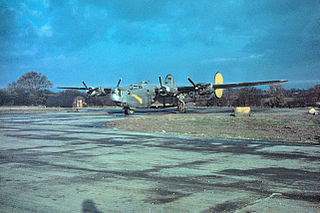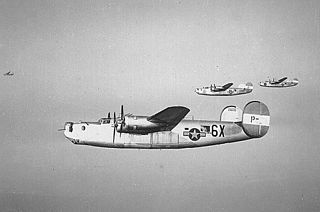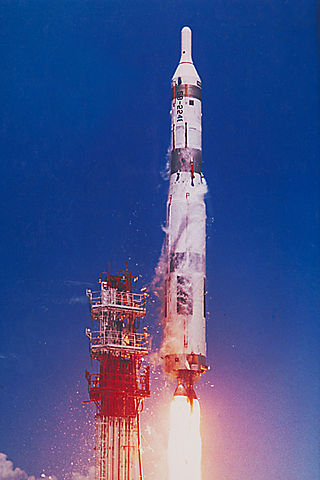
The 484th Air Expeditionary Wing is a provisional United States Air Force unit assigned to Air Combat Command. It may be activated or inactivated at any time. It was activated and attached to United States Air Forces Central for the invasion of Iraq in 2003. It was headquartered at Prince Sultan Air Base, Saudi Arabia.

The 346th Bombardment Group is a former United States Army Air Forces unit. It was last assigned to the 316th Bombardment Wing at Kadena Airfield, Okinawa, where it was inactivated on 30 June 1946. The group was originally a heavy bomber training unit, but was inactivated in a general reorganization of Army Air Forces training units in 1944. It was reorganized as a Boeing B-29 Superfortress group later that year. It moved to Okinawa in 1945, but arrived too late to participate in combat.

The 493d Bombardment Group is a former United States Army Air Forces unit that was assigned to the 92d Bombardment Wing during World War II. It the last bombardment group to be assigned to Eighth Air Force. It flew combat missions in the strategic bombing campaign against Germany until shortly before V-E Day, then returned to the United States for inactivation. In 2002, the group was converted to provisional status as the 493d Air Expeditionary Group and assigned to Air Mobility Command to activate or inactivate as needed.

The 15th Special Operations Squadron is part of the 1st Special Operations Wing at Hurlburt Field, Florida. It operates Lockheed MC-130J Commando II aircraft in support of special operations.

The 820th Bombardment Squadron is a former Army Air Forces unit, inactivated on 4 January 1946. The squadron was first activated during World War II as the 521st Bombardment Squadron. The squadron was soon engaged in the antisubmarine campaign off the Atlantic coast of the United States as the 16th Antisubmarine Squadron.

The 867th Attack Squadron is an active United States Air Force unit. It was reactivated at Creech Air Force Base, Nevada, on 10 September 2012 as a remotely piloted aircraft squadron.

The 819th Bombardment Squadron is an inactive United States Air Force unit. Its last assignment was with the 30th Bombardment Group at Kahuku Army Air Field, Hawaii, where it was inactivated on 30 November 1945.

The 14th Antisubmarine Squadron is a disbanded United States Army Air Forces unit. It was activated in 1942 as the 519th Bombardment Squadron and flew antisubmarine missions off the Atlantic coast until the Navy assumed its mission. It then moved to Texas, where it was disbanded in November 1943 and its personnel were used as cadres for heavy bomber groups.

The 847th Bombardment Squadron is a former United States Army Air Forces unit that was originally activated as the 421st Bombardment Squadron. Its last assignment was with the 489th Bombardment Group at Great Bend Army Air Field, Kansas where it was inactivated on 28 March 1945. As the 20th Antisubmarine Squadron, the squadron performed antisubmarine patrols in 1942 and 1943. After reforming as a heavy bomber squadron, it engaged in the strategic bombing campaign against Germany in the European Theater of Operations until returning to the United States in late 1944. The squadron was inactivated while its parent group was training as a very heavy bombardment unit.

The 855th Bombardment Squadron is an inactive United States Air Force unit. The squadron was first activated as the 522d Bombardment Squadron at Lantana Airport, Florida, in October 1942, when it assumed the personnel and equipment of a National Guard unit engaged in antisubmarine warfare over the Atlantic. The squadron continued antisubmarine patrols as the 17th Antisubmarine Squadron until the summer of 1943, when its mission was transferred to the Navy.

The 831st Bombardment Squadron was a squadron of the United States Army Air Forces. It was activated in 1942 as the 516th Bombardment Squadron and flew antisubmarine missions off the Atlantic coast as the 11th Antisubmarine Squadron. Later, it saw combat in the Mediterranean Theater of Operations as a Consolidated B-24 Liberator unit, where it earned a Distinguished Unit Citation during the strategic bombing campaign against Germany. Following V-E Day, the squadron returned to the United States and was inactivated at Sioux City Army Air Base, Iowa on 20 August 1945.

The 859th Special Operations Squadron is a reserve unit of the United States Air Force. It was first activated in October 1942 as the 517th Bombardment Squadron, when the Army Air Forces replaced National Guard observation units that had been mobilized and were performing antisubmarine patrols off the Atlantic coastline. A month after its activation, the squadron was redesignated the 12th Antisubmarine Squadron. In August 1943, the Army Air forces began turning the antisubmarine patrol mission over to the Navy and the squadron moved to California, where, as the 859th Bombardment Squadron, it formed the cadre for the 492d Bombardment Group.

The 835th Bombardment Squadron is an inactive United States Army Air Forces unit. It was activated in January 1941 as the 80th Bombardment Squadron and equipped with Douglas A-20 Havoc light bombers. Following the attack on Pearl Harbor the squadron began to fly antisubmarine patrols off the Atlantic coast and over the Caribbean Sea, becoming the 9th Antisubmarine Squadron.

The 863rd Bombardment Squadron is a former United States Army Air Forces unit. It was first organized as the 518th Bombardment Squadron in October 1942, when it replaced a National Guard unit participating in antisubmarine patrols off the Atlantic coast, becoming the 13th Antisubmarine Squadron in November. When the Navy took over the coastal antisubmarine mission in August 1943, the squadron moved to the western United States, where it formed the cadre for the 493rd Bombardment Group and was redesignated as the 863rd. It moved to England in the spring of 1944 and participated in the strategic bombing campaign against Germany until April 1945. It returned to the United States and was inactivated in August 1945.

The 851st Strategic Missile Squadron is an inactive United States Air Force unit. It was last assigned to the 456th Strategic Aerospace Wing, stationed at Beale Air Force Base, California. It was equipped with the HGM-25A Titan I intercontinental ballistic missile, with a mission of nuclear deterrence. It was the last Titan I squadron to achieve alert status on 1 February 1961. The squadron was inactivated as part of the phaseout of the Titan I on 25 March 1965.

The 482d Operations Group is a United States Air Force Reserve unit assigned to the 482d Fighter Wing. It is stationed at Homestead Air Reserve Base, Florida.

The 825th Bombardment Squadron is an inactive United States Air Force unit. It was assigned to the 484th Bombardment Group and was last stationed at Casablanca Airport, French Morocco, where it was inactivated on 25 July 1945. The squadron was activated during World War II as a Consolidated B-24 Liberator unit. It served in combat in the Mediterranean Theater of Operations, earning two Distinguished Unit Citations for operations over Germany and Austria. Following V-E Day it operated with Air Transport Command in returning American troops to the United States until it was inactivated in theater in the summer of 1945.

The 826th Bombardment Squadron is an inactive United States Air Force unit. It was assigned to the 484th Bombardment Group and was last stationed at Casablanca Airport, French Morocco, where it was inactivated on 25 July 1945. The squadron was activated during World War II as a Consolidated B-24 Liberator unit. It served in combat in the Mediterranean Theater of Operations, earning two Distinguished Unit Citations for operations over Germany and Austria, during the strategic bombing campaign against Germany. Following V-E Day it operated with Air Transport Command in returning American troops to the United States.

The 839th Bombardment Squadron is an inactive United States Army Air Forces unit. It was activated in January 1941 as the 79th Bombardment Squadron and equipped with Douglas A-20 Havoc light bombers. Following the attack on Pearl Harbor the squadron began to fly antisubmarine patrols off the Atlantic coast and over the Caribbean Sea, becoming the 8th Antisubmarine Squadron.

The Army Air Forces Antisubmarine Command was formed in the fall of 1942 to establish a single command to control antisubmarine warfare (ASW) activities of the Army Air Forces (AAF). It was formed from the resources of I Bomber Command, which had been carrying out the antisubmarine mission in the Atlantic and Caribbean since the Attack on Pearl Harbor due to the lack of long range Naval aviation in that area.

























